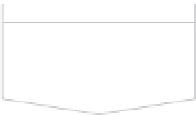Agriculture Reference
In-Depth Information
Ditch
Substrate
Soil
PE film
Drain
Rigid frame
Substrate
Gutter
Drain
Soil
PE film
Rockwool
Polystyrene
Slab
Drain
Soil
Substrate
PE film
Polystyrene
Bag
Drain
Soil
Fig. 10.1.
Most common substrate cultivation systems.
Chemical properties
The volumetric relations between dif-
ferent geometrical dispositions of perlite
(P-2 type, grain size between 0 and 5 mm) and
of rockwool are shown in Plates 22 and 23,
respectively. The value of limiting the
height of the substrate to maximize water
content can be observed.
Other important characteristic of
those substrates that are a mixture of par-
ticles, which influences the porosity, is
the size distribution of the particles.
A very important physical property is the
hydraulic conductivity of the substrate, as
it has a crucial influence on the avail-
ability of water to the crop. Also of inter-
est are: (i) the capacity of the substrate to
re-wet; (ii) its apparent density; and
(iii) how much it contracts in volume
(Raviv and Lieth, 2008).
The ideal substrate must not only be devoid
of harmful substances, especially of heavy
metals, but also it must be chemically inert,
which is not the case in some organic
substrates.
The CEC (cation exchange capacity)
defines the quantity of cations that can be
fixed per unit volume or weight of the sub-
strate. Substrates with no or very low CEC
will be the most convenient. The CEC is
important in organic substrates and it is
advisable to saturate the substrate before its
use with calcium supplies, with the aim of
minimizing the CEC, so it does not affect
the availability of nutrients scheduled for
use in fertilization.
Some materials can be acidifying
(e.g. peat), or cause a basic reaction in
















